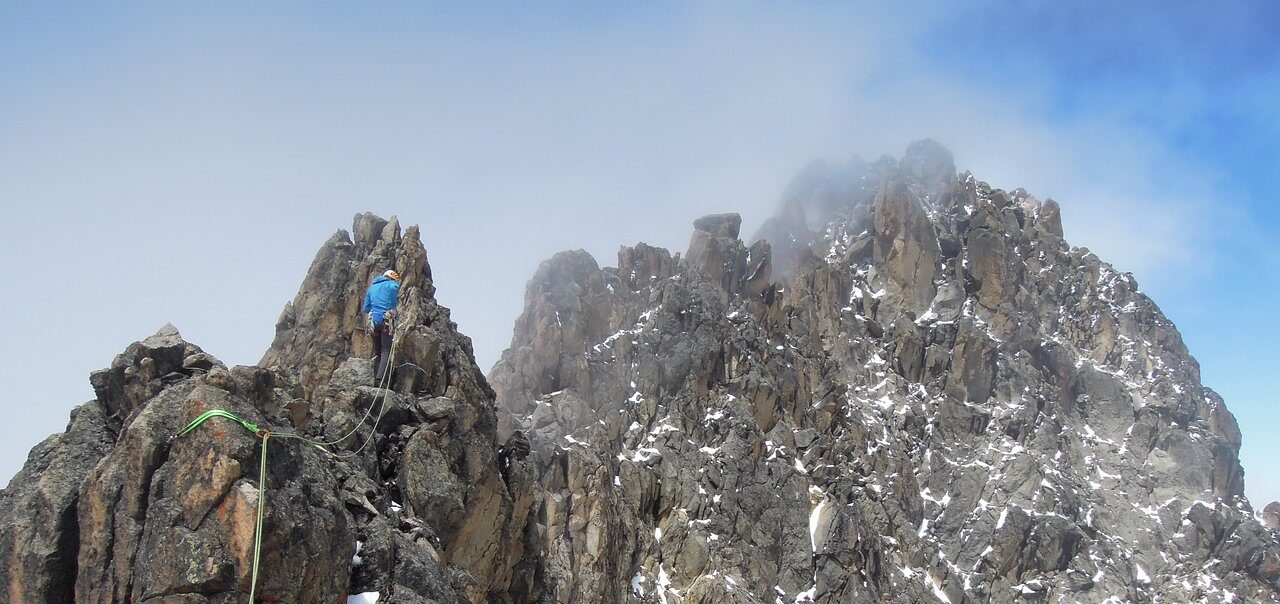Destination
Mount Kenya - Kenya
Type
- Hiking
Duration
7 days
Share

A 7 Days Hike | Mount Kenya Tours
<p>Mount Kenya, Africa's second-highest peak at 5,199 meters, is a majestic extinct stratovolcano and a UNESCO World Heritage Site, located in central Kenya. Renowned for its breathtaking landscapes, diverse ecosystems, and cultural significance, it is a premier destination for adventurers, hikers, and nature enthusiasts. As a vital water catchment area, Mount Kenya supports Kenya’s rivers and sustains local communities, while its afro-alpine flora and fauna, including rare species like the Mount Kenya mole shrew, make it a biodiversity hotspot. Key Features of Mount Kenya Geographical Significance: Situated approximately 150 km northeast of Nairobi, Mount Kenya straddles the equator, offering unique equatorial glacier views. Its highest peaks, Batian (5,199m), Nelion (5,188m), and Lenana (4,985m), attract climbers worldwide.</p> <p>Ecosystems and Wildlife: The mountain hosts diverse zones, from dense montane forests to bamboo jungles, moorlands, and alpine meadows. Wildlife includes elephants, buffaloes, leopards, and the endemic Mount Kenya rock hyrax.</p> <p>Cultural Importance: Revered by the Kikuyu, Meru, and Embu communities, Mount Kenya is considered a sacred site, often referred to as "Kirinyaga" (the place of light) in Kikuyu culture.</p> <p>Climbing and Trekking: Popular routes like Sirimon, Chogoria, and Naro Moru offer varied trekking experiences, with Point Lenana being the most accessible summit for non-technical climbers. The mountain’s challenging terrain draws both novice and experienced mountaineers.</p> <p>Conservation Status: As a UNESCO World Heritage Site and part of Mount Kenya National Park, conservation efforts focus on protecting its ecosystems from climate change and human encroachment.</p> <p>Updated Information (2025) Climbing Seasons: The best times to climb Mount Kenya are January-March and July-October, avoiding the rainy seasons (April-June and November-December) for safer treks. Recent weather data indicates stable conditions in early 2025, with minimal snowfall disruptions.</p> <p>Conservation Efforts: In 2025, Kenya Wildlife Service (KWS) and local NGOs have intensified reforestation and anti-poaching patrols to preserve Mount Kenya’s ecosystems. New eco-tourism initiatives promote sustainable travel.</p> <p>Tourism Trends: Posts on X highlight Mount Kenya’s growing popularity among international hikers, with a 15% increase in visitors reported in 2024. Local guides now offer virtual tours and Swahili-language content to cater to diverse audiences.</p> <p>Infrastructure Improvements: Upgraded trails and eco-lodges around Chogoria and Sirimon routes enhance visitor experiences, with better signage and waste management systems introduced in 2024.</p> <p>Climate Impact: Recent studies note glacial retreat due to climate change, with conservationists urging climbers to follow low-impact practices.</p> <p>Hike Mount Kenya: Africa’s Hidden Gem in 2025</p> <p>Explore Mount Kenya, a UNESCO World Heritage Site and Africa’s second-highest peak. Plan your trek with top routes like Sirimon and Chogoria, discover unique afro-alpine wildlife, and learn why January-March is the best time to climb. Book your adventure today</p>
Price: $2910
Duration: 7 days
Location: Mount Kenya, Kenya
Type: Hiking
About This Destination
Mount Kenya, Africa's second-highest peak at 5,199 meters, is a majestic extinct stratovolcano and a UNESCO World Heritage Site, located in central Kenya. Renowned for its breathtaking landscapes, diverse ecosystems, and cultural significance, it is a premier destination for adventurers, hikers, and nature enthusiasts. As a vital water catchment area, Mount Kenya supports Kenya’s rivers and sustains local communities, while its afro-alpine flora and fauna, including rare species like the Mount Kenya mole shrew, make it a biodiversity hotspot. Key Features of Mount Kenya Geographical Significance: Situated approximately 150 km northeast of Nairobi, Mount Kenya straddles the equator, offering unique equatorial glacier views. Its highest peaks, Batian (5,199m), Nelion (5,188m), and Lenana (4,985m), attract climbers worldwide. Ecosystems and Wildlife: The mountain hosts diverse zones, from dense montane forests to bamboo jungles, moorlands, and alpine meadows. Wildlife includes elephants, buffaloes, leopards, and the endemic Mount Kenya rock hyrax. Cultural Importance: Revered by the Kikuyu, Meru, and Embu communities, Mount Kenya is considered a sacred site, often referred to as "Kirinyaga" (the place of light) in Kikuyu culture. Climbing and Trekking: Popular routes like Sirimon, Chogoria, and Naro Moru offer varied trekking experiences, with Point Lenana being the most accessible summit for non-technical climbers. The mountain’s challenging terrain draws both novice and experienced mountaineers. Conservation Status: As a UNESCO World Heritage Site and part of Mount Kenya National Park, conservation efforts focus on protecting its ecosystems from climate change and human encroachment. Updated Information (2025) Climbing Seasons: The best times to climb Mount Kenya are January-March and July-October, avoiding the rainy seasons (April-June and November-December) for safer treks. Recent weather data indicates stable conditions in early 2025, with minimal snowfall disruptions. Conservation Efforts: In 2025, Kenya Wildlife Service (KWS) and local NGOs have intensified reforestation and anti-poaching patrols to preserve Mount Kenya’s ecosystems. New eco-tourism initiatives promote sustainable travel. Tourism Trends: Posts on X highlight Mount Kenya’s growing popularity among international hikers, with a 15% increase in visitors reported in 2024. Local guides now offer virtual tours and Swahili-language content to cater to diverse audiences. Infrastructure Improvements: Upgraded trails and eco-lodges around Chogoria and Sirimon routes enhance visitor experiences, with better signage and waste management systems introduced in 2024. Climate Impact: Recent studies note glacial retreat due to climate change, with conservationists urging climbers to follow low-impact practices. Hike Mount Kenya: Africa’s Hidden Gem in 2025 Explore Mount Kenya, a UNESCO World Heritage Site and Africa’s second-highest peak. Plan your trek with top routes like Sirimon and Chogoria, discover unique afro-alpine wildlife, and learn why January-March is the best time to climb. Book your adventure today
Activities